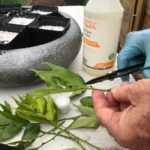Here’s what’s new in the garden this week at the Earth-Kind® Demonstration Garden at Travis County AgriLife Extension and the Travis County Master Gardener garden at Pfluger Pedestrian Bridge.
Is it Okay to Cut Back Plants?
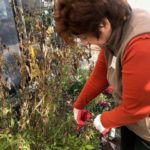
Removing dead foliage after a freeze – Yay or Nay?
The recent freeze damaged some of the perennial foliage and flowering plants. JoAnna, the Pollinator Garden leader advises that it’s okay to remove dead foliage on perennials, but hold off pruning woody shrubs. All of the annual vines that didn’t survive were added to the compost pile. To see what else can be done this month, check out the monthly gardening calendar.
Spots of Color Throughout
January in Austin seems to cover all seasons, often in the span of a day. Right now the Four Nerve Daisy, Tetraneuris scaposa, is determined to outshine the sun. There are several patches of this bright cheery native flower throughout the garden on Smith Road. These plants form small colonies and most gardeners find them to be trouble free.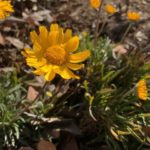
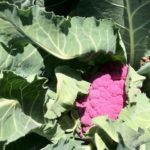 Hidden over in the vegetable garden, another jewel is shining. The ‘Graffiti’ cauliflower, Brassica oleracea, has formed a bright pink head that is showing off in front of the other winter garden plants. The vibrant color will fade when the vegetable is cooked, providing a great incentive to eat it raw.
Hidden over in the vegetable garden, another jewel is shining. The ‘Graffiti’ cauliflower, Brassica oleracea, has formed a bright pink head that is showing off in front of the other winter garden plants. The vibrant color will fade when the vegetable is cooked, providing a great incentive to eat it raw.
Propagating Plants for the Inside Austin Gardens Tour
The Inside Austin Gardens Tour by the Travis County Master Gardeners is set for May 16, 2020, and will feature a plant sale at the Demonstration Garden on Smith Road. The goal for the sale is to feature plants from each of the gardens on the tour. Bob, the Master Gardener Compost Area leader, has volunteered to help propagate plants from the Earth-Kind® Demonstration Garden (which is on the tour.) Always up for a challenge, Bob is experimenting with leaf cuttings from the Holly Fern, Cyrtomium falcatum. This fern is grown from commercially from spores or rhizome divisions. If Bob’s method works, he’ll have several plants to contribute in May.
Crop Failure and Overabundance in the Vegetable Garden
There is nothing more frustrating than planting seeds and having a poor, or in this case, a zero germination rate. That’s exactly what happened to David, the Vegetable Garden Area Leader. Not one seed of the Salada Musume burdock, Arctium lappa, germinated. Burdock is better known as a common weed that produces burs, but the stems and roots can be quite edible if prepared properly. Japan has long cultivated the plant for it’s culinary value. David is guessing that the seeds may have been too old or just a bad batch.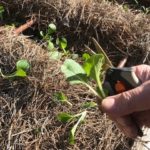
Right next to the Burdock are several overcrowded Pac choi seedlings, Brassica rapa subsp. chinensis. In stark contrast, it seems that every seed of the ‘Joi Choi’ hybrid seeds have become plants. David recommends using scissors or clippers to thin overcrowded seedlings, rather than pulling them up. Removing an entire plant will disturb the soil around the survivors, and may result in the tender roots being exposed to the crazy January weather. Clip the seedling right at the base and remove the tops. They make excellent salad greens, by the way.
Chamomile Escapes from Garden Bed
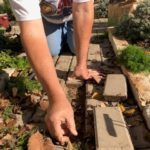 Over in the herb garden, the chamomile-like Dusky dogfennel, Chamaemelum fuscatum, has produced a prodigious amount of seedlings. Trouble is, Pat, the Herb Garden Area Leader, wanted the seedlings to appear in the herb bed, not the adjacent walkway. Master Gardener Charles was dispatched to carefully dig them up and transplant them into their proper home.
Over in the herb garden, the chamomile-like Dusky dogfennel, Chamaemelum fuscatum, has produced a prodigious amount of seedlings. Trouble is, Pat, the Herb Garden Area Leader, wanted the seedlings to appear in the herb bed, not the adjacent walkway. Master Gardener Charles was dispatched to carefully dig them up and transplant them into their proper home.
This particular type of chamomile is different than the regular German Chamomile, Matricaria chamomilla (which Pat also has in the garden.) It has much larger flowers and is more likely to be found in California. It’s part of the same Asteraceae family. No word from Pat if it makes a good cup of tea.
Plants Taken From Pfluger Pedestrian Bridge
Mr. Dickens wrote in A Tale of Two Cities, “It was the best of times, it was the worst of times.” You might recall that we wrote about an Echeveria suddenly appearing in the garden bed; this week, most of the plants have disappeared – including the recent donation. The garden is under renovation and apparently someone decided to help themselves. Jane, the Pfluger Pedestrian Bridge Garden Leader, discovered the issue when she arrived to irrigate. These things happen in a public garden, and the proper authorities have been notified. Jane just hopes the new owners take care of their acquisitions and compliments them on their plant choice. New plants will be added to the bed later this month.
